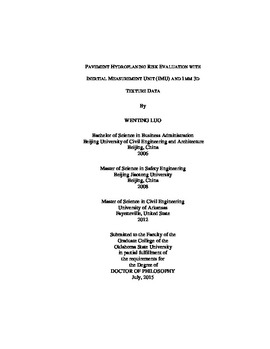| dc.contributor.advisor | Wang, Kelvin C. P. | |
| dc.contributor.author | Luo, Wenting | |
| dc.date.accessioned | 2017-02-22T22:11:08Z | |
| dc.date.available | 2017-02-22T22:11:08Z | |
| dc.date.issued | 2015-07 | |
| dc.identifier.uri | https://hdl.handle.net/11244/48896 | |
| dc.description.abstract | During wet weather automobiles traveling on pavements may experience hydroplaning that would cause out-of-control accidents. Annually 14% of all accidents with fatalities occur on wet pavements. However, not many studies have been conducted on identifying pavement sections with hydroplaning risks for pavement safety survey purpose. This is primarily due to two facts: 1) that it is difficult to acquire the high-quality texture and geometry data which serve as basis data for hydroplaning study; 2) that the existing hydroplaning speed prediction models may not be applicable on irregular pavement sections e.g. pavements with large slopes or long rutting track. To overcome these limitations, in this study PaveVision3D Ultra is used to collect 1mm 3D texture data with full lane coverage at highway speed. Inertial Measurement Unit (IMU) system is used to measure the geometry feature of pavements such as cross slope and longitudinal grade. ANalysis Of VAriance (ANOVA) test results indicated the collected texture data have good reliabilities if the data collection is conducted at a constant speed, while IMU data have the good repeatability regardless of data collection speed. Subsequently the existing prediction models are evaluated by validating the predicted water film depth (WFD) and hydroplaning speed with the measured values from eTape liquid level sensor and Dynamic Friction Tester (DFT). Results indicate the predicted values from Gallaway and University of South Florida (USF) models have good agreements with the ground truth. However, the two models only functions well on regular pavement. For pavements with large slopes or long rutting track, the models might work properly since effects of large slope and rutting on hydroplaning are not considered. In this study impacts of large slopes on vertical load are considered and incorporated the existing models. A new model named as 3S-WFD model is developed in the research to estimate water film depth of rutting pavement under three scenarios. Finally case studies are provided for hydroplaning evaluation on regular pavements, large sloping pavements, and rutting pavements, respectively. Results indicate the data and models used in this study can efficiently identify pavement segments with potential hydroplaning risks so that pavement engineers can take remedial measures to minimize potential traffic accidents. The methodologies proposed in the research would be beneficial in complementing the network level pavement safety survey by highway agencies. | |
| dc.format | application/pdf | |
| dc.language | en_US | |
| dc.rights | Copyright is held by the author who has granted the Oklahoma State University Library the non-exclusive right to share this material in its institutional repository. Contact Digital Library Services at lib-dls@okstate.edu or 405-744-9161 for the permission policy on the use, reproduction or distribution of this material. | |
| dc.title | Pavement hydroplaning risk evaluation with Inertial Measurement Unit (IMU) and 1mm 3D texture data | |
| dc.contributor.committeeMember | Cross, Stephen Alan | |
| dc.contributor.committeeMember | Li, Qiang | |
| dc.contributor.committeeMember | Habiger, Joshua | |
| osu.filename | LUO_okstate_0664D_14113.pdf | |
| osu.accesstype | Open Access | |
| dc.type.genre | Dissertation | |
| dc.type.material | Text | |
| thesis.degree.discipline | Civil Engineering | |
| thesis.degree.grantor | Oklahoma State University | |
